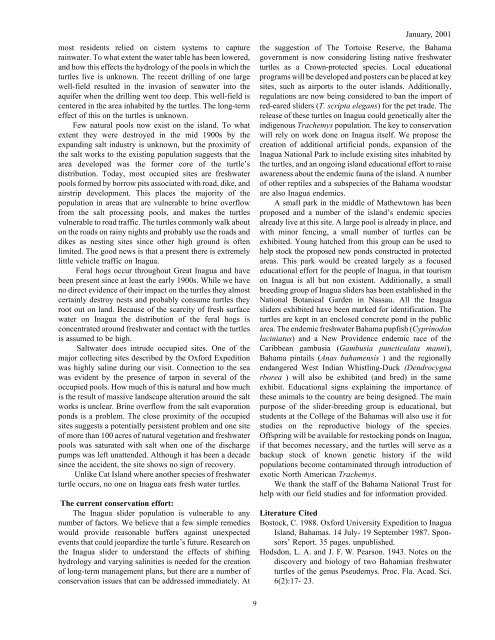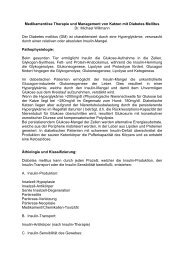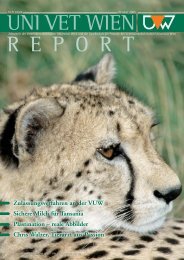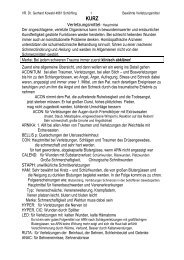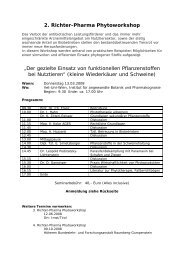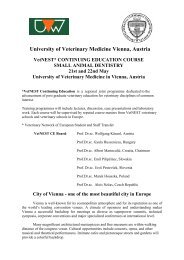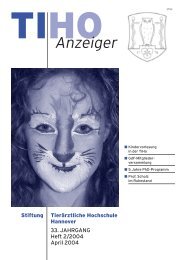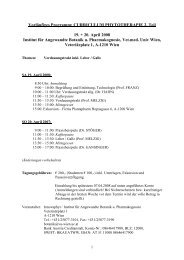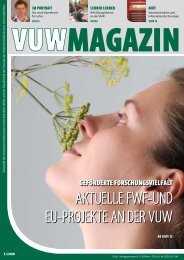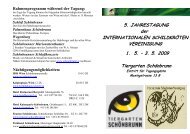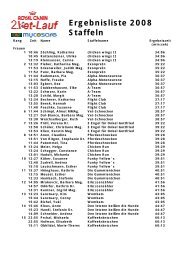Turtle and Tortoise Newsletter - VET-MAGAZIN.com
Turtle and Tortoise Newsletter - VET-MAGAZIN.com
Turtle and Tortoise Newsletter - VET-MAGAZIN.com
Create successful ePaper yourself
Turn your PDF publications into a flip-book with our unique Google optimized e-Paper software.
most residents relied on cistern systems to capturerainwater. To what extent the water table has been lowered,<strong>and</strong> how this effects the hydrology of the pools in which theturtles live is unknown. The recent drilling of one largewell-field resulted in the invasion of seawater into theaquifer when the drilling went too deep. This well-field iscentered in the area inhabited by the turtles. The long-termeffect of this on the turtles is unknown.Few natural pools now exist on the isl<strong>and</strong>. To whatextent they were destroyed in the mid 1900s by theexp<strong>and</strong>ing salt industry is unknown, but the proximity ofthe salt works to the existing population suggests that thearea developed was the former core of the turtle’sdistribution. Today, most occupied sites are freshwaterpools formed by borrow pits associated with road, dike, <strong>and</strong>airstrip development. This places the majority of thepopulation in areas that are vulnerable to brine overflowfrom the salt processing pools, <strong>and</strong> makes the turtlesvulnerable to road traffic. The turtles <strong>com</strong>monly walk abouton the roads on rainy nights <strong>and</strong> probably use the roads <strong>and</strong>dikes as nesting sites since other high ground is oftenlimited. The good news is that a present there is extremelylittle vehicle traffic on Inagua.Feral hogs occur throughout Great Inagua <strong>and</strong> havebeen present since at least the early 1900s. While we haveno direct evidence of their impact on the turtles they almostcertainly destroy nests <strong>and</strong> probably consume turtles theyroot out on l<strong>and</strong>. Because of the scarcity of fresh surfacewater on Inagua the distribution of the feral hogs isconcentrated around freshwater <strong>and</strong> contact with the turtlesis assumed to be high.Saltwater does intrude occupied sites. One of themajor collecting sites described by the Oxford Expeditionwas highly saline during our visit. Connection to the seawas evident by the presence of tarpon in several of theoccupied pools. How much of this is natural <strong>and</strong> how muchis the result of massive l<strong>and</strong>scape alteration around the saltworks is unclear. Brine overflow from the salt evaporationponds is a problem. The close proximity of the occupiedsites suggests a potentially persistent problem <strong>and</strong> one siteof more than 100 acres of natural vegetation <strong>and</strong> freshwaterpools was saturated with salt when one of the dischargepumps was left unattended. Although it has been a decadesince the accident, the site shows no sign of recovery.Unlike Cat Isl<strong>and</strong> where another species of freshwaterturtle occurs, no one on Inagua eats fresh water turtles.The current conservation effort:The Inagua slider population is vulnerable to anynumber of factors. We believe that a few simple remedieswould provide reasonable buffers against unexpectedevents that could jeopardize the turtle’s future. Research onthe Inagua slider to underst<strong>and</strong> the effects of shiftinghydrology <strong>and</strong> varying salinities is needed for the creationof long-term management plans, but there are a number ofconservation issues that can be addressed immediately. AtJanuary, 2001the suggestion of The <strong>Tortoise</strong> Reserve, the Bahamagovernment is now considering listing native freshwaterturtles as a Crown-protected species. Local educationalprograms will be developed <strong>and</strong> posters can be placed at keysites, such as airports to the outer isl<strong>and</strong>s. Additionally,regulations are now being considered to ban the import ofred-eared sliders (T. scripta elegans) for the pet trade. Therelease of these turtles on Inagua could genetically alter theindigenous Trachemys population. The key to conservationwill rely on work done on Inagua itself. We propose thecreation of additional artificial ponds, expansion of theInagua National Park to include existing sites inhabited bythe turtles, <strong>and</strong> an ongoing isl<strong>and</strong> educational effort to raiseawareness about the endemic fauna of the isl<strong>and</strong>. A numberof other reptiles <strong>and</strong> a subspecies of the Bahama woodstarare also Inagua endemics.A small park in the middle of Mathewtown has beenproposed <strong>and</strong> a number of the isl<strong>and</strong>’s endemic speciesalready live at this site. A large pool is already in place, <strong>and</strong>with minor fencing, a small number of turtles can beexhibited. Young hatched from this group can be used tohelp stock the proposed new ponds constructed in protectedareas. This park would be created largely as a focusededucational effort for the people of Inagua, in that tourismon Inagua is all but non existent. Additionally, a smallbreeding group of Inagua sliders has been established in theNational Botanical Garden in Nassau. All the Inaguasliders exhibited have been marked for identification. Theturtles are kept in an enclosed concrete pond in the publicarea. The endemic freshwater Bahama pupfish (Cyprinodonlaciniatus) <strong>and</strong> a New Providence endemic race of theCaribbean gambusia (Gambusia puncticulata manni),Bahama pintails (Anas bahamensis ) <strong>and</strong> the regionallyendangered West Indian Whistling-Duck (Dendrocygnarborea ) will also be exhibited (<strong>and</strong> bred) in the sameexhibit. Educational signs explaining the importance ofthese animals to the country are being designed. The mainpurpose of the slider-breeding group is educational, butstudents at the College of the Bahamas will also use it forstudies on the reproductive biology of the species.Offspring will be available for restocking ponds on Inagua,if that be<strong>com</strong>es necessary, <strong>and</strong> the turtles will serve as abackup stock of known genetic history if the wildpopulations be<strong>com</strong>e contaminated through introduction ofexotic North American Trachemys.We thank the staff of the Bahama National Trust forhelp with our field studies <strong>and</strong> for information provided.Literature CitedBostock, C. 1988. Oxford University Expedition to InaguaIsl<strong>and</strong>, Bahamas. 14 July- 19 September 1987. Sponsors’Report. 35 pages. unpublished.Hodsdon, L. A. <strong>and</strong> J. F. W. Pearson. 1943. Notes on thediscovery <strong>and</strong> biology of two Bahamian freshwaterturtles of the genus Pseudemys. Proc. Fla. Acad. Sci.6(2):17- 23.9


